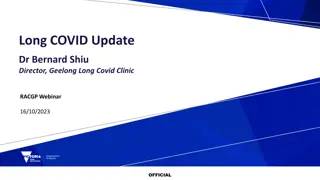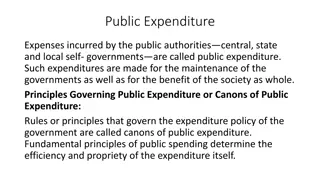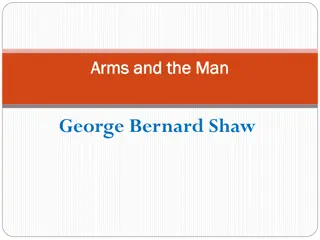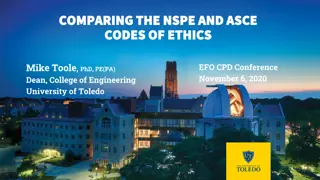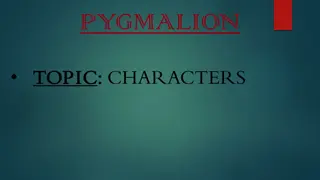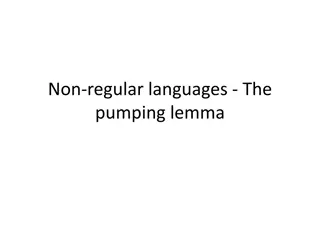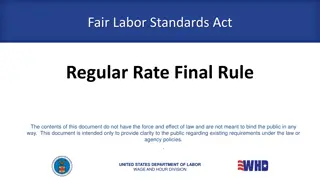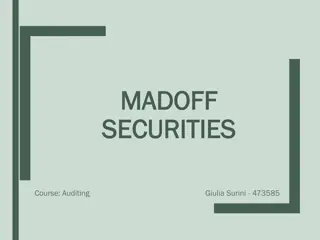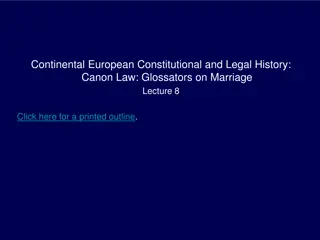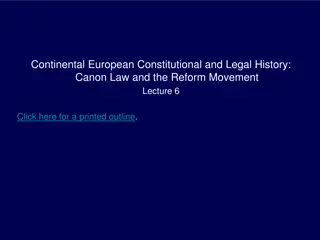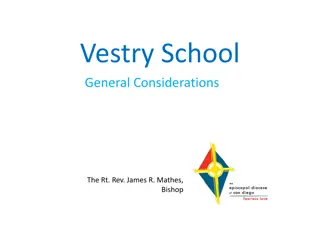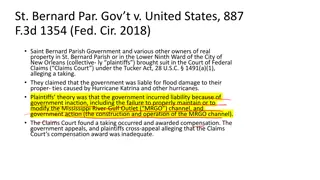Overview of Crusades II: Monasticism, Bernard of Clairvaux, and Canons Regular
Delve into the world of the Crusades through the lens of Monasticism, with a focus on the Cistercians led by St. Bernard of Clairvaux, known for his opposition to worldly pleasures and his special devotion to Mary. Explore the role of Canons Regular, such as the Canons Regular of Premontre (Norbitines), representing a middle ground between monks and secular clergy, with responsibilities that include teaching and preaching.
Download Presentation

Please find below an Image/Link to download the presentation.
The content on the website is provided AS IS for your information and personal use only. It may not be sold, licensed, or shared on other websites without obtaining consent from the author.If you encounter any issues during the download, it is possible that the publisher has removed the file from their server.
You are allowed to download the files provided on this website for personal or commercial use, subject to the condition that they are used lawfully. All files are the property of their respective owners.
The content on the website is provided AS IS for your information and personal use only. It may not be sold, licensed, or shared on other websites without obtaining consent from the author.
E N D
Presentation Transcript
Lecture 16 Crusades II Dr. Ann T. Orlando 25 October 2018 1
Introduction Subsequent crusading movements Religious orders Internal crusade the Inquisition 2
Monasticism: Citeaux Reform of Cluny: Cistercians Founded by St. Robert Molesme at Citeaux 1099 Return to strict adherence to Benedict s Rule; work equal with prayer and study Each monastery independent; that is, each had its own abbot More severe artistic style Bernard of Clairvaux most famous Cistercian (1090-1153) Modern day Trappists; Spencer, MA. SJS 3
Bernard of Clairvaux (1090-1153) Bernard was the son and brother of knights Established Cistercian monastery at Clairvaux Opposed Peter Abelard (1078-1142): I must understand in order that I might believe Opposed Cluny-type monasticism as being too interested in worldly beauty and pleasure Preached the Second Crusade (1144) Wrote very length commentary on Song of Songs in which he refers to both Gregory of Nyssa and Origen; highly allegorical Special devotion to Mary Encouraged mysticism that moved away from physical; apophatic SJS 4
St. Bernards Devotion to Mary Mary subject of many homilies Author of famous Marian prayer REMEMBER, O most gracious Virgin Mary, that never was it known that anyone who fled to thy protection, implored thy help, or sought thy intercession was left unaided. Inspired with this confidence, I fly to thee, O Virgin of virgins, my Mother; to thee do I come; before thee I stand, sinful and sorrowful. O Mother of the Word Incarnate, despise not my petitions, but in thy mercy hear and answer me. Amen.
Orders of Canons Regular Considered a quid medium between monks and secular clergy First developed during Charlemagne s rule as part of clerical reform Like monks Lived in community Prayed Divine Office together Unlike monks Ordination to priesthood expected Responsible for teaching and preaching, Often under direct authority of local bishop Because of duties, followed Augustine's Rule 6
Canons Regular of Premontre (Norbitines) Established by St. Norbert (1080-1134) in 1120 An effort to create dedicated priests removed from temptations of secular world. St. Norbert was a friend of St. Bernard, who encouraged him to found the Norbitines Norbitines follow Augustine's Rule 7
Bernards Opponents within Church Abbot Suger (1081-1151) Abbot of Cluniac monastery near (today within) Paris, St. Denis Confident of French King Louis VII, witnessed his marriage to Eleanor of Aquitaine Developed an early Gothic style at St. Denis Man rises to God through beauty Bernard vehemently opposed this style, wrote the Apology against it Peter Abelard (1079 1142) Attended as student, then teacher at Cathedral School of Notre-Dame in Paris Canon of Notre-Dame, but engaged in famous romance with Heloise; ending in his castration by her relatives Abelard became a monk at St Denis; Heloise became a nun Abelard s theology very rational: I must understand in order to believe. Bernard accused him of heresy 5
Crusading Orders Knights Templar Hospitallers of St John (later Knights of Malta) Teutonic Knights 9
Knights Templar Founded after capture of Jerusalem by First Crusade c 1119 to protect pilgrims from bands of Muslim robbers in Holy Land Called Templars because they lived on Temple Mount in Jerusalem Rule of life written by Bernard of Clairvaux He wanted to establish a new knighthood In seeking papal approval of Templars, Bernard wrote that what was necessary was fighting knights not singing and wailing monks. Fought during all subsequent crusades, including in Spain Templars became very wealthy and powerful with vast landholdings in Europe Established a type of banking system with letters of credit for pilgrims Establish Temples for their order throughout Europe These Temples were also the site of much international banking 10
Second Crusade (1145-1149) Turks recaptured Edessa and threaten Holy Land St. Bernard of Clairvaux preached this crusade, Primarily German (HRE) and French troops Offered same plenary indulgence as Urban II had during First Crusade Discouraged attacks on Jews in Rhineland Military disaster in East Crusading armies from France and Germany not coordinated, distrustful of each other and Byzantines Did not win back Edessa Attacked but did not take Damascus; attacked but did not conquer Egypt Result: union of Syria and Egypt against the Western Crusaders 11
Eleanor of Aquitaine (1122- 1204) Duchess of Aquitaine, largest and most important province in France First married King of France, Louis VII She took the cross with Louis after hearing Bernard preach the Second Crusade Travelled to Outremer to be with her uncle, Count Raymond, king of Antioch (Both Abbot Suger and Bernard disapproved saying Eleanor was too head strong) Eleanor not satisfied with Louis; supposedly saying I wanted a man but married a monk Their marriage was annulled She then married Henry of Normandy, who quickly became Henry II of England Their marriage resulted in 2 kings (Richard the Lionhearted and John I) She sided with Henry II over St. Thomas Becket She intrigued against Henry II with her son Henry, resulting in her house arrest until Henry II died She became regent and ruler of England while her son Richard was on the 3rd Crusade until John old enough to become regent 12
Eleanor and Knightly Chivalry Eleanor established a court of knightly love She encouraged troubadours and poets to write about romance The following can be traced to her influence: Story of Templars and Holy Grail (Perceval) King Arthur and Round Table 13
Saladin (1137-1193) Born in Tigrit (Iraq), family were Kurds Spent early life in Damascus Rose to military prominence leading local army against various Arab and Turkish factions Pressure from Western crusades and his exceptional military ability led to victories that extended his rule from Persia to North Africa Having unified political and military authority, was able to push Crusaders out of Jerusalem and most of previously won areas Saladin was respected for his justice by both Muslims and Christians 14
Third Crusade (1187-1192) Because of unified Syria and Egypt, Muslims under Saladin were able to retake Jerusalem in 1187 Saladin made it a point not to engage in same kind of blood-bath as First Crusade King s Crusade Richard I (Lionhearted) of England Phillip II of France Fredrick Barbarossa of HRE Military stalemate Crusaders manage to hold onto Acre, but could not retake Jerusalem Richard negotiates a peace with Saladin guaranteeing safety of Christian pilgrims On his way home, Richard imprisoned by Germans, eventually ransomed 15
Development of Italian City- States Since collapse of Western Roman Empire, various parts of Italy ruled by invaders Goths Lombards Byzantines Carolingians Muslims Vikings Papal States As a result, and because its geography lends itself to defense by small groups, cities become local centers of stability Italian cities develop strong diplomatic and defensive military capabilities From foreigners Against each other 16
Some Terminology Commune: urban areas (towns) reliant on an outside force for protection Communes were self-governing Communes often joined together for mutual defense Also known as universitas City-states are a special class of universitas which conduct their own foreign policy and trade agreements 17
Economic Development of City-States Moved from land-based wealth to mercantile wealth Italian City-States develop extensive (world-wide) trading agreements And become adept and playing off papacy and HRE against each other Naval prowess most important Genoa and Venice were major trading sea-based mercantile empires 18
Example: Marco Polo (1254- 1324) 19
Fourth Crusade (1202-1204) Intended to recapture Jerusalem Preached by Pope Innocent III Ignored by most kings and rulers Encouraged by Venetians and Genoese An unruly mob of Western mercenaries sail to Constantinople In spite of Innocent III threatening to excommunicate anyone who molests Constantinople, city is attacked and taken Three-day horrendous sack, rape, murder, pillage, wonton destruction Many artifacts (horses in St. Mark s Sq in Venice) and relics (St. John Chrysostom and St. Gregory Nazianzus) end up in St. Peter s Basilica in Rome Venetians and Genoese rule Constantinople until Byzantines win it back in 1261 20
Impact of Fourth Crusade and Sack of Constantinople Confirmed the worst fears of Eastern Christians about Western (Christian) barbarians Resentment by Orthodox Christians lasts to today Apologizing for Sack is a part of John Paul II effort to bring the two lungs of Christianity closer together The relics of John Chrysostom and Gregory Nazianzus were returned in 2004 The Fourth Crusade was the last crusade encouraged by the papacy 21
Later Eastern Crusades Children s Crusade of 1212; adolescent and pre- teenage children went to Holy Land and were slaughtered or taken as slaves; led by 10 year olds Fifth Crusade, 1217-1221, led by Austrians and Hungarians Sixth Crusade, 1228-1229, led by HRE Fredrick II; briefly retook Jerusalem Seventh and Eighth Crusade, 1248-1254, led by King Louis IX of France (later proclaimed saint) who was taken captive and eventually ransomed Acre falls in 1291 22
Impact of Crusades Within Europe Crusades against Jews Crusading Orders Inquisition The Western Front: reconquest of Spain 23
Crusades against Jews Some took call to take up arms against enemies of Christianity as license to persecute Jews in Europe Especially horrendous during the People s Crusade in Rhineland Mob of Christians rampage against Jews Large Jewish populations in Mainz and other towns destroyed In large measure a way to finance crusades Same thing occurs during Second Crusade Bernard of Clairvaux goes to Mainz and convinces leaders of mobs to cease Bishops often tried to protect Jews from local mobs Pope Calixtus II issues Sicut Jadaeis in 1120 Jews have right to property Jews should not be forced to convert Jews can conduct their own religious services Violation carries excommunication 24
The Internal Crusade: The Inquisition Starts as Church opposition to Albingensian (Cathars) in Southern France Similar to (a type of?) Manichaeism Spread with Muslim invasions through Spain 1208 Innocent III declares crusade against Albingensians Barons and bishops of northern France mount bloody and successful conquest of Southern France Asks St. Dominic 1233 Inquisition established to find heretics Both a religious and a political institution Remember: political and religious unity not distinguished Example: St. Jean D Arc executed by English Inquisition (1431) 25
The Church Reflects on Inquisition Tertio Milennio Advente 35 Another painful chapter of history to which the sons and daughters of the Church must return with a spirit of repentance is that of the acquiescence given, especially in certain centuries, to intolerance and even the use of violence in the service of truth. It is true that an accurate historical judgment cannot prescind from careful study of the cultural conditioning of the times 26
Western Crusade: Reconquista 711: The Muslim conquest of Iberia begins. 721: Charles Martel wins Battle of Tours 800: Charlemagne completes the reconquest of all of today's southern French territory and the Pyrenees 914: Completion of the reconquest of the north-west. 1085: Toledo reconquered by Castilian forces. 1147: Lisbon and most of Portugal retaken 1236: Half of Iberia has been reconquered by the Christians. 1300s and 1400s: Continuing slow push of Spanish forces south led by Castile and Aragon. 1492: Victorious Ferdinand and Isabel, Treaty of Granada completes the Reconquista. NB With the Christian unification of the Iberian peninsula, Spain will become the dominant world- wide power in the following century 27
Assignments Bernard of Clairvaux, In Praise of New Knighthood, https://history.hanover.edu/courses/excerpts/344 bern2.html AND Apology, http://sourcebooks.fordham.edu/source/bernard1. asp The Sack of Constantinople, available at http://www.fordham.edu/halsall/source/choni ates1.html 28
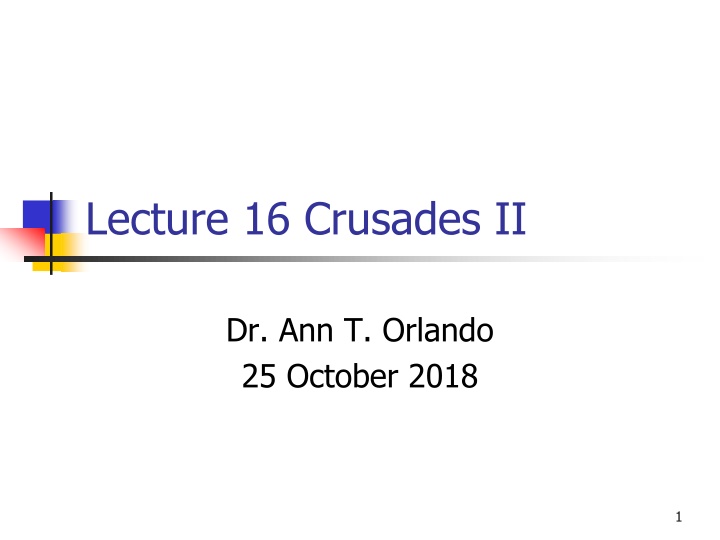

![❤[PDF]⚡ Civil War Talks: Further Reminiscences of George S. Bernard and His Fel](/thumb/20551/pdf-civil-war-talks-further-reminiscences-of-george-s-bernard-and-his-fel.jpg)
